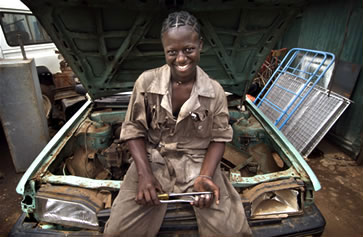Wanted: jobs for Africa’s youth
Wanted: jobs for Africa’s youth
African leaders are expressing a renewed sense of urgency to tackle youth unemployment on the continent and are beginning to develop and implement plans to create jobs. “In Africa, the problem of youth unemployment is more complex than in some other parts of the world,” says Kenyan President Mwai Kibaki. “Slow-growing economies are unable to generate enough job opportunities to absorb the large number of young people qualifying from institutions of learning every year,” he told delegates at a Youth Employment Summit (YES) in Nairobi, Kenya, in September.
 A young woman professionally trained as an auto mechanic in Kenya: Creating jobs for women poses particular challenges.
A young woman professionally trained as an auto mechanic in Kenya: Creating jobs for women poses particular challenges.“The evidence stares us in the face on the streets of our major cities,” says Ms. Ngozi Okonjo-Iweala, who until recently was Nigeria’s finance minister. “Young men and women [are] roaming the streets with little to do, operating motorcycle taxis . . . and in some cases engaging in criminal activities.”
Reducing the world’s rate of youth unemployment by half could add $2,200 bn – $3,500 bn to the global economy, estimates the International Labour Organization (ILO). About 20 per cent of that gain would go to sub-Saharan Africa.
The Nairobi summit was organized by the YES Campaign, a network of nonprofit organizations operating in 60 countries around the world. It brought together about 2,000 young people, leaders from more than 120 countries and representatives of donor agencies to develop solutions.
President Kibaki says it is critical for African countries to come up with specific plans that target youth. Most employment policies fail to take into account the particular needs of young people or the fact that creating employment for women often poses its own challenges. There is a realization in many countries that youth, both male and female, are at a disadvantage on the job market. Even if they have had some schooling, many lack skills and job experience. Those who want to set up their own businesses do not have money. In many companies, last-in, first-out hiring policies mean that young people are the first to lose their jobs when a company is in distress.
 African governments need capacity and good policies to stimulate job creation.
African governments need capacity and good policies to stimulate job creation.Time for action
Young people (between 15 and 24 years old) made up 63 per cent of the jobless in sub-Saharan Africa in 2003, even though they constituted just 33 per cent of the labour market. Reported unemployment in Africa averages 10 per cent, but unofficially the figures are much higher, with some countries experiencing unemployment rates of more than 40 per cent. In Botswana, 43 per cent of young people were officially unemployed in 1998, compared with 13 per cent of adults. In Zambia, recent estimates had 30 per cent of adults as jobless, compared with 60 per cent of youths. Although the UN defines “youth” as those between 15 and 24 years, in some countries the definition includes those who are as old as 35.
A complex mix of factors contributes to Africa’s unemployment figures. It includes stagnant or sluggish economies that are not growing fast enough to produce jobs for a growing population. Development experts say that Africa’s economy needs to grow by 7 per cent annually in order to cut in half by 2015 the percentage of people living in poverty, a target agreed upon by the international community. Because many countries have weak industries, manufacturing cannot absorb large numbers of the unemployed. Low rates of literacy and educational systems that do not equip young people with the skills required on the job market also fuel unemployment.
A number of long-term national policy options to deal with unemployment have so far been proposed — with limited results. In September 2004, African leaders decided to adopt a continental strategy, known as the Ouagadougou Plan of Action. Endorsed at an African Union (AU) summit on employment in Burkina Faso, the plan calls on countries to diversify their economies into labour-intensive industries, adopt laws that attract investors and create opportunities for women and young workers.
“The Plan of Action is a fine blueprint,” says UN Economic Commission for Africa (ECA) Executive Secretary Abdoulie Janneh. “But we must go beyond the planning stage,” he told the annual conference of African ministers of finance, economic planning and development in Burkina Faso in May 2006. “More than ever, it is up to us to act on our words, embedding the Plan of Action into national development programmes.”
The AU reports that since 2004 progress has been made in some countries. “The Ouagadougou Summit led to the setting in motion of a number of activities in various countries,” says AU Commissioner for Economic Affairs Maxwell Mkwezalamba. For instance, Malian President Amadou Toumani Touré has declared youth employment his first national priority, Ghana has set aside $110 mn in its 2006 budget for a National Youth Employment Programme and, with World Bank assistance, Ethiopia is designing labour market policies to make job creation a core element. Mr. Mkwezalamba reports that Chad and Madagascar, among other countries, have prepared national employment plans, while Tanzanian President Jakaya Kikwete has directed the labour ministry to identify sectors that could potentially hasten the creation of more than a million jobs annually.
Job plans
However, most countries have not yet incorporated job creation plans into their national development frameworks. The national strategies include anti-poverty programmes, commonly based on Poverty Reduction Strategy Papers (PRSPs). These are documents developed with assistance from the World Bank and the International Monetary Fund (IMF) to set national priorities, direct spending of debt-relief funds and coordinate donor programmes.
“In view of their centrality in the development of low-income countries, PRSPs could be a major instrument for promoting youth employment,” comments Mr. Makha Dado Sarr, a former deputy executive secretary of ECA. “PRSPs have become major development programmes of the countries concerned, since they presently constitute the basis of the assistance provided by international financial institutions” and by most other multinational and bilateral development partners.
The ECA and AU are leading a drive to encourage African countries to incorporate job plans into their PRSPs. As part of this effort, ECA convened a PRSP review conference in Cairo, Egypt, in March 2006. Participants examined 21 poverty reduction strategies and found that two-thirds now contain basic job-creation measures, a significant improvement over the first generation of PRSPs, which barely covered employment issues. Some of these measures include plans to widen access to education, training and credit and to build infrastructure and attract investors. But, judged the ECA, none of the 21 PRSPs “substantially and explicitly confronted employment issues and challenges.”
Broadening consultation
At the PRSP review in Cairo, Tanzania’s anti-poverty programme was commended for containing some measurable goals, specific targets and time periods by which job plans would be carried out. The World Bank had approved Tanzania’s first PRSP in 2000. That one reflected little input from employers and workers, despite a general requirement that the preparation of the documents involve domestic stakeholders. But by the time Tanzania produced its second strategy in 2005, the labour ministry, with assistance from the ILO, had incorporated suggestions from the national employers’ association and the trade unions.
“In part, the weakness of the employment policy dimension of PRSPs probably reflects the relative absence of labour ministries and their social partners from the consultation processes for the drafting of the first papers,” noted the ILO. Larger questions, such as how to translate economic growth into jobs, are yet to be fully integrated into poverty reduction strategies, but “this is likely to change as PRSPs evolve.”
Tanzania’s current PRSP requires the government to promote business-friendly policies, provide flexible loans to support poor women in setting up businesses and encourage small and micro-enterprises. But, as with the other PRSPs under review, Tanzania’s strategy does not address youth unemployment as a specific challenge requiring special attention. By grouping youth together with all other job seekers, such plans overlook young people’s particular economic and social needs.
‘Bad policy’
Since the mid-1990s, economic performance has improved significantly in many African countries, with average annual growth in gross domestic product (GDP) rising steadily from less than 3 per cent in 1998 to 5 per cent in 2005. In theory, according to many economists, this should have led to higher employment.
However, notes Ms. Okonjo-Iweala, the former Nigerian finance minister, “In most of our countries, economic growth is not resulting in significant job creation and therefore in poverty reduction.”
This lack of job opportunities contributes to many social problems. Without alternatives, many young women and girls are forced into sex work. Studies show that young jobless people living on the street are more likely than their employed counterparts to abuse illicit substances or join armed groups.
“Jobless growth isn’t just bad social policy, it is bad economics,” says ILO Director-General Juan Somavia. “It results in less consumption, more migration, more child labour and lower aggregate demand.” Those maladies in turn lead to reduced investments, less funding for pensions, lower tax revenue and other resources for social policies, and ultimately more poverty.
Diversification
The Youth Employment Network, an alliance of countries initiated by UN Secretary-General Kofi Annan in collaboration with the heads of the ILO and World Bank, recommends that governments diversify their economies and promote sectors that use a lot of workers. Many African economies still rely on the production of one or two primary commodities. They could diversify into processing these commodities or producing light manufactures, as Mauritius has successfully done.
Over two decades, Mauritius has averaged 6 per cent annual economic growth, resulting in a fourfold increase in per capita income and virtually eliminating unemployment. The government attracted investors to the country’s principal exports, sugar and garments. It also furthered diversification by promoting export processing zones (EPZs), which featured incentives for investors but also allowed workers to form and join unions (unlike in the EPZs of some other countries).
Between 1983 and 1986, employment in Mauritius’s EPZs tripled and by 1985 the EPZ sector had overtaken sugar as the prime source of exports, foreign exchange earnings and employment. Today Mauritius is no longer able to compete so effectively with other textile producers, such as China. So it is restructuring its economy, moving into other sectors such as financial services, light engineering goods, precision plastics and computer products.
Education and training
“It is clear that to rise out of poverty, the people of our continent need jobs and education,” says ECA Executive Secretary Janneh. “Not just any job, but one that provides a decent wage and employment conditions.” According to the Addis Ababa-based ECA, it is crucial for countries to expand training, lifelong learning, education and other means of improving skills, with a particular focus on young people.
As a start, many countries need to rebuild a formal education system that declined rapidly during the last few decades from the effect of cost-cutting measures adopted at the urging of the World Bank and IMF, notes an ILO study led by University of Zambia lecturer Francis Chigunta. These austerity policies, known as “structural adjustment,” led to deep cuts in public spending, including for food, health and education. Many schools were obliged to introduce fees, contributing to a decline in attendance by students from poor families.
Many countries are now trying to boost school enrolment rates, with some success. The special emphasis on getting more girls into school should ultimately improve the employability of young women in Africa. However, an estimated 45 million children aged between 6 and 11 still do not attend school in Africa.
Other studies highlight shortcomings in the focus of many educational systems in Africa, which concentrate on educating students for often nonexistent formal white-collar jobs, rather than for technical or factory-type work, which may be available.
To increase the employability of the 1 million young school-leavers entering the job market annually without appropriate skills, the Egyptian government in 1991 began to provide technical and vocational training to secondary school students. Over a three-year period, students spend two days a week at school and four days a week in training in a business. More than 1,600 companies are involved in the programme, which has so far reached more than 15,000 students. Graduates often find immediate employment or set up their own small enterprises.
Entrepreneurship
Another focus of action has been on spreading entrepreneurship skills beyond the schools. A number of countries have introduced entrepreneurship training programmes, including Gambia, Kenya, Malawi, Nigeria, Swaziland and Zimbabwe. Policymakers believe that the promotion of small-business enterprises and the informal sector offer quick solutions to joblessness.
In Nigeria, which has more than 10 million small-business owners, the government supports new entrepreneurs through a network of about 20 industrial development centres that train youth, help them turn their ideas into feasible business ventures and supply them with credit.
But many of these programmes are not easily accessible to women, notes Ms. Christiana Okojie of the University of Benin, Nigeria. “Studies have shown that women tend to benefit less … as they are crowded out by men,” she reports. Women are at the back of the job queue, since they generally have lower levels of education, due in part to cultural and other biases against the training of girls. Ms. Okojie argues that governments should put in place deliberate affirmative action policies for poor, rural women and should establish training programmes in sectors that employ many women, such as trading and agricultural processing.
Responding to the need for gender-specific programmes, women lawyers, bankers, entrepreneurs and trainers set up the Kenya Women Finance Trust in 1981. It is the only micro-finance institution in the country exclusively for women, and it has more than 100,000 members. It grants cheap credit to low-income earners to start small businesses.
Public works
In many countries, immediate, short-term solutions are needed to quickly ease the burden of unemployment. Public works programmes are a popular option. South Africa, which commits more than $800 mn to public works, has one of the best programmes on the continent, reports the ILO. In terms of technical design standards and the quality of completed physical infrastructure, the country’s public works programme “was regarded as surpassing anything that the ILO members of an evaluation team had encountered in more than 30 developing countries in Africa, Asia and the Pacific,” notes the ILO.
The Community Based Public Works Programme, designed to provide rapid and visible relief to the poor, helped create 130,000 jobs between 1998 and 2004. In the latter year, the government launched the Enhanced Public Works Programme, with a goal of creating a million jobs over five years. The programme employs unskilled and semi-skilled people to build schools, hospitals and roads, giving them short-term incomes and, hopefully, long-term skills.
“Public works are popular with politicians as they offer the opportunity for a government to claim to be ‘creating jobs’ in a far more direct and observable way than through the opaque medium of long-term processes which deliver genuine economic growth and employment,” comments South African economist Anna McCord.
But in a context of chronic poverty, which is neither cyclical nor temporary, public works programmes will not have a significant or sustained impact, she adds. This is because the jobs offered are short-term — lasting only about 4 months — and the wages are low. Even if South Africa’s programme were to create the envisaged 200,000 jobs annually, that would benefit only a small fraction of the country’s poor and unemployed. Out of a population of 45 million, 24 million live below the poverty line.
Policy reforms
“For successful poverty reduction, African countries have to be in the driver’s seat,” says World Bank Africa Region Vice-President Gobind Nankani. “Africans know best where the shoe pinches. They should craft their own poverty-reduction strategies based on national realities.”
But many countries in Africa are hampered by the inability of the state to deliver social services. Development policies followed in many African countries during the 1980s emphasized macroeconomic prudence, which translated into a reduction in the size and role of the public sector. In Zimbabwe for example, the cabinet in 1995 ordered all ministries to cut staff by 40 per cent, in line with the conditions of a World Bank loan. Weakened by similar cutbacks, labour ministries in many African countries found themselves with no capacity to plan or direct employment-generation programmes.
There is now a growing realization among African policymakers and their external development partners that the state needs to be rebuilt so that it can play an active role in development.
Mr. Nankani notes that African governments could benefit from directing investment into rural areas. Two-thirds of Africa’s population lives in the countryside and poverty is predominantly a rural phenomenon. The rural poor work in small-scale, subsistence farming and non-farm activities such as agro-processing. Governments could therefore promote policies that increase agricultural productivity and growth. These may include policies to raise the quality of labour, through training, and to improve the productivity of land. Rural industrialization programmes could create jobs in particularly disadvantaged communities.
Business-friendly
In the short term, countries need to do away with policies that hinder investment, notes the World Bank in its report Doing Business in 2006: Creating Jobs. African countries impose the most stringent regulations on entrepreneurs, the Bank reports. In Mozambique an investor typically must go through 14 separate procedures over an average of 153 days in order to register a business, while in Sierra Leone a company may have to spend 164 per cent of its gross profits to pay all its business taxes.
The report ranks 155 countries according to how they have reformed their policies to attract investors. Exemplary reformers on the continent include Rwanda, which has reformed its courts and customs procedures. The report praises Mozambique for cutting the property transfer tax from 10 to 2.4 per cent of the property value, the largest such reduction in the world.
African countries need to put their houses in order, says Mr. Nankani. Economic growth and job creation will remain elusive in countries where public policy “chokes private enterprise and discourages business activities.”
Unemployment threatens peace and security
In a number of African countries, youth unemployment is part of a vicious cycle. Jobless youth are more susceptible to joining the ranks of the rebel movements, armies and pro-government militias that have been battling each other in the continent’s numerous wars. In turn, war leads to more joblessness because of its impact on a country’s economy, infrastructure and human resources.
The challenge is stopping this vicious cycle, says UN Under-Secretary-General and Special Adviser on Africa Legwaila Joseph Legwaila. This can only be done if the youth are productively engaged. “They must have something useful to do. But a country that has gone through war often does not have jobs,” he says.
In African countries emerging from war, UN peacekeepers are carrying out disarmament, demobilization and reintegration (DDR) programmes to try to create lasting peace. Sierra Leone’s war ended in 2002, and the UN supported the reintegration of 48,000 ex-fighters. However, the challenge of creating lasting jobs in one of the poorest countries in the world remains immense. More than 50 per cent of young people in Sierra Leone still lack proper work.
Liberia faces a similar predicament and is seeking ways to keep its 100,000 young ex-fighters economically engaged. Many are taking part in that country’s reintegration programme, in which they are trained and placed back into their communities, notes President Ellen Johnson-Sirleaf. The challenge now, she says, is to get them into long-term ventures or school so that when the current programme ends “we will not find them back in a state of unemployment, a state of helplessness.”
A recent UN report, Youth Unemployment and Regional Insecurity in West Africa, describes the high levels of unemployment among young men and women in West Africa as “a ticking time bomb.” The study, produced by the UN Office for West Africa, warns that progress and security in the entire region is undermined by the “growing numbers of youths who lack prospects of ever being able to work for a reasonable living.”
The concerns of youth and their potential to contribute to development have not attracted sufficient attention from policymakers in Africa. To help redress this shortcoming, Mr. Legwaila’s Office of the Special Adviser on Africa is convening a regional meeting in Namibia in November. It will bring together youth and regional experts to discuss reintegration of young ex-combatants into society, as well as job creation and access to basic services, such as water, health and education.
















